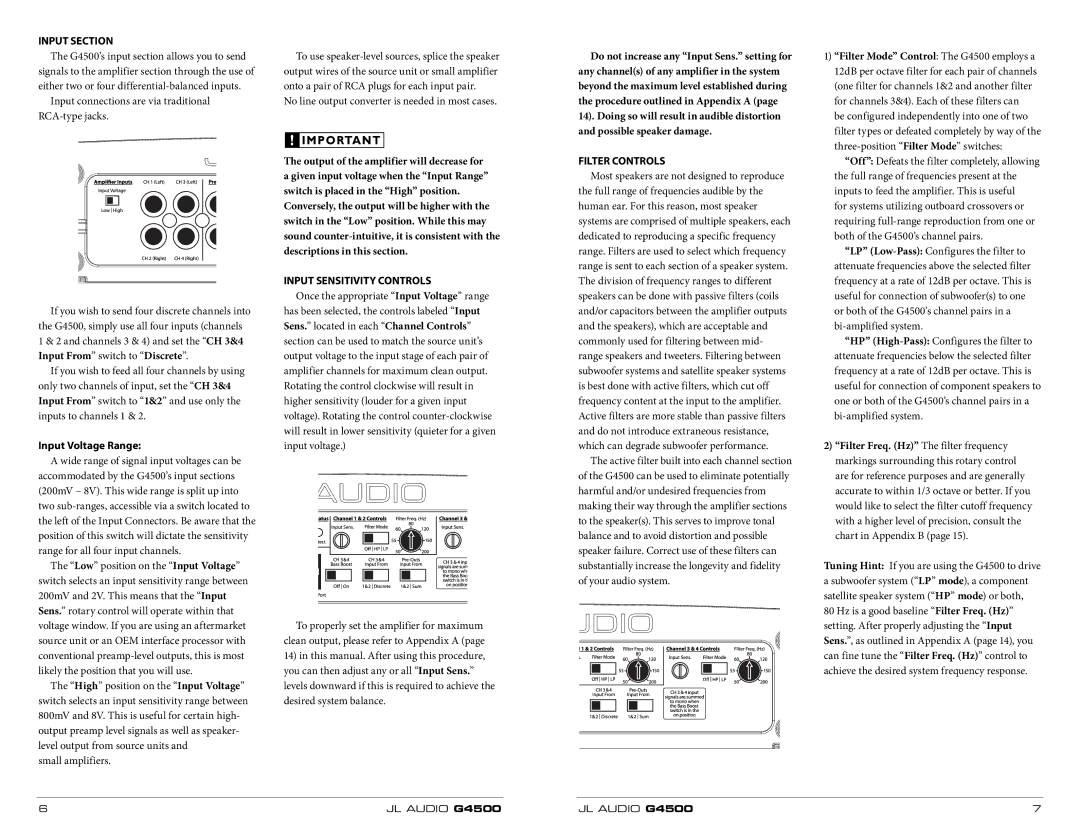Input Section
The G4500’s input section allows you to send signals to the amplifier section through the use of either two or four differential-balanced inputs.
Input connections are via traditional RCA-type jacks.
If you wish to send four discrete channels into the G4500, simply use all four inputs (channels
1 & 2 and channels 3 & 4) and set the “CH 3&4 Input From” switch to “Discrete”.
If you wish to feed all four channels by using
only two channels of input, set the “CH 3&4 Input From” switch to “1&2” and use only the inputs to channels 1 & 2.
Input Voltage Range:
A wide range of signal input voltages can be accommodated by the G4500’s input sections (200mV – 8V). This wide range is split up into two sub-ranges, accessible via a switch located to the left of the Input Connectors. Be aware that the position of this switch will dictate the sensitivity range for all four input channels.
The “Low” position on the “Input Voltage”
switch selects an input sensitivity range between 200mV and 2V. This means that the “Input Sens.” rotary control will operate within that voltage window. If you are using an aftermarket source unit or an OEM interface processor with conventional preamp-level outputs, this is most likely the position that you will use.
The “High” position on the “Input Voltage” switch selects an input sensitivity range between 800mV and 8V. This is useful for certain high- output preamp level signals as well as speaker- level output from source units and
small amplifiers.
To use speaker-level sources, splice the speaker output wires of the source unit or small amplifier onto a pair of RCA plugs for each input pair.
No line output converter is needed in most cases.
The output of the amplifier will decrease for a given input voltage when the “Input Range” switch is placed in the “High” position.
Conversely, the output will be higher with the switch in the “Low” position. While this may sound counter-intuitive, it is consistent with the descriptions in this section.
Input Sensitivity Controls
Once the appropriate “Input Voltage” range has been selected, the controls labeled “Input Sens.” located in each “Channel Controls” section can be used to match the source unit’s output voltage to the input stage of each pair of amplifier channels for maximum clean output. Rotating the control clockwise will result in higher sensitivity (louder for a given input voltage). Rotating the control counter-clockwise will result in lower sensitivity (quieter for a given input voltage.)
To properly set the amplifier for maximum clean output, please refer to Appendix A (page
14)in this manual. After using this procedure, you can then adjust any or all “Input Sens.” levels downward if this is required to achieve the desired system balance.
Do not increase any “Input Sens.” setting for any channel(s) of any amplifier in the system beyond the maximum level established during the procedure outlined in Appendix A (page
14). Doing so will result in audible distortion and possible speaker damage.
Filter Controls
Most speakers are not designed to reproduce the full range of frequencies audible by the human ear. For this reason, most speaker systems are comprised of multiple speakers, each dedicated to reproducing a specific frequency range. Filters are used to select which frequency range is sent to each section of a speaker system. The division of frequency ranges to different speakers can be done with passive filters (coils and/or capacitors between the amplifier outputs and the speakers), which are acceptable and commonly used for filtering between mid- range speakers and tweeters. Filtering between subwoofer systems and satellite speaker systems is best done with active filters, which cut off frequency content at the input to the amplifier. Active filters are more stable than passive filters and do not introduce extraneous resistance, which can degrade subwoofer performance.
The active filter built into each channel section of the G4500 can be used to eliminate potentially harmful and/or undesired frequencies from making their way through the amplifier sections to the speaker(s). This serves to improve tonal balance and to avoid distortion and possible speaker failure. Correct use of these filters can substantially increase the longevity and fidelity of your audio system.
1)“Filter Mode” Control: The G4500 employs a 12dB per octave filter for each pair of channels (one filter for channels 1&2 and another filter for channels 3&4). Each of these filters can be configured independently into one of two filter types or defeated completely by way of the three-position “Filter Mode” switches:
“Off”: Defeats the filter completely, allowing the full range of frequencies present at the inputs to feed the amplifier. This is useful
for systems utilizing outboard crossovers or requiring full-range reproduction from one or both of the G4500’s channel pairs.
“LP” (Low-Pass):Configures the filter to attenuate frequencies above the selected filter frequency at a rate of 12dB per octave. This is useful for connection of subwoofer(s) to one or both of the G4500’s channel pairs in a bi-amplified system.
“HP” (High-Pass):Configures the filter to attenuate frequencies below the selected filter frequency at a rate of 12dB per octave. This is useful for connection of component speakers to one or both of the G4500’s channel pairs in a bi-amplified system.
2)“Filter Freq. (Hz)” The filter frequency markings surrounding this rotary control are for reference purposes and are generally accurate to within 1/3 octave or better. If you would like to select the filter cutoff frequency with a higher level of precision, consult the chart in Appendix B (page 15).
Tuning Hint: If you are using the G4500 to drive a subwoofer system (“LP” mode), a component satellite speaker system (“HP” mode) or both, 80 Hz is a good baseline “Filter Freq. (Hz)” setting. After properly adjusting the “Input Sens.”, as outlined in Appendix A (page 14), you can fine tune the “Filter Freq. (Hz)” control to achieve the desired system frequency response.

